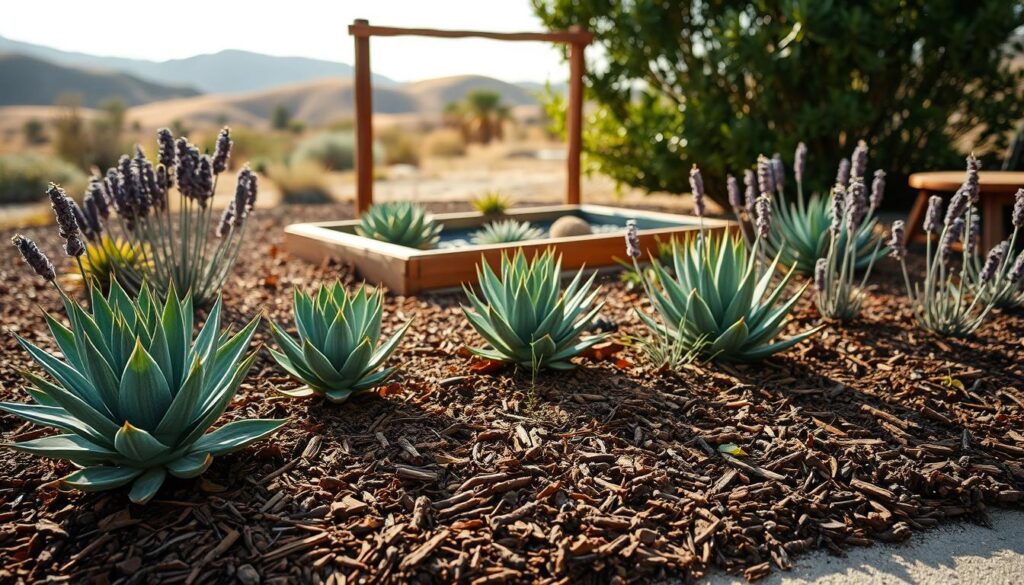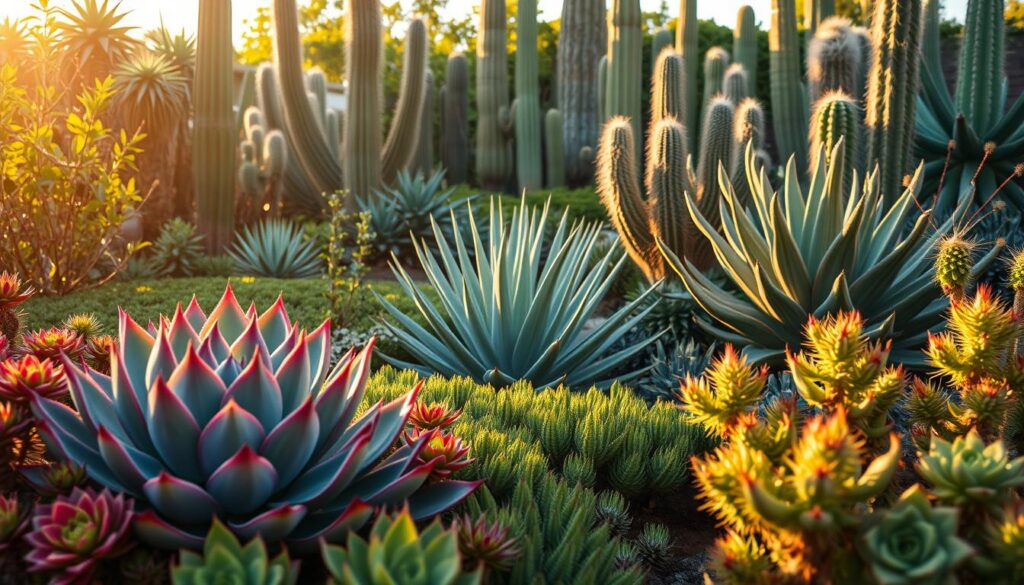Water conservation is key today, and drought-resistant plants are a top choice. They’re great for gardens and landscapes that save water. You can make a beautiful, green space without wasting water.

To have a successful drought-resistant garden, you need to know how to care for it. Our guide will teach you everything. You’ll learn about the benefits, how to care for them, and more.
Introduction to Water-Wise Gardening
With the right steps, you can make a beautiful garden that saves water. Our tips will show you how to pick the best plants and design your garden. You’ll learn to create a stunning, water-saving garden.
Key Takeaways
- Choose drought-resistant plants suitable for your climate and soil type
- Implement proper watering techniques for xeriscaping success
- Use mulching strategies to conserve water and reduce evaporation
- Select the right location for your drought-resistant garden
- Understand the benefits of water-wise gardening and xeriscaping
- Learn how to care for and maintain your drought-resistant plants
Understanding Drought-Resistant Plants
Drought-resistant plants are made to grow well with little water. They’re great for low-water landscaping and sustainable gardening practices. These plants have special traits that help them save water and handle dry spells.
These plants often have deep roots, waxy leaves, or small leaves. These features help them store water and cut down on water loss. Succulents and cacti are perfect examples for drought-tolerant plants gardens.
Adding drought-resistant plants to your garden cuts down on water use and upkeep. It’s good for the planet and saves money. Growing water-wise plants offers several benefits:
- Lower water bills
- Less time on gardening chores
- More resistance to pests and diseases
Learning about drought-resistant plants helps you make a stunning, eco-friendly garden. It needs little water and care.
Selecting the Right Location for Your Drought-Resistant Garden
Creating a drought-resistant garden is all about the right spot. Most drought-resistant plants need full sun or partial shade. Also, they love well-draining soil to avoid soggy soil.
Start by checking your yard’s sunlight. Look for areas that get full sun and those that are shaded. Then, test your soil’s drainage and type. If it’s heavy clay or holds water, add organic matter to fix it.
Here are some tips for the perfect spot for your drought-resistant garden:
- Choose a spot with full sun to partial shade
- Select an area with well-draining soil
- Assess the soil quality and amend it if necessary
- Consider the slope and elevation of your yard to ensure proper drainage
Follow these tips and pick the right spot for your drought-resistant garden. You’ll have a stunning outdoor space that’s easy to care for and saves water.
Essential Soil Requirements for Water-Wise Plants
Soil quality is key for a drought-resistant garden. A well-draining soil mix is essential for your plants’ success. It helps roots grow and prevents waterlogged soil. The best mix includes sand, silt, clay, and organic matter for healthy microbes.
Adding compost or manure can improve your soil. They boost water-holding and nutrient levels. Good drainage is also crucial to avoid root rot. With the right soil mix and amendments, your plants will thrive.
- Soil pH levels
- Nutrient content
- Water-holding capacity
- Drainage rates
Understanding these can help you create a soil that supports your plants’ health and resilience.
Proper Drought-Resistant Plants Care Techniques
To keep your drought-resistant plants healthy, you need to care for them right. This means using watering methods like deep watering. It helps plants grow strong roots. Also, avoid overwatering to prevent root rot and other issues.
Pruning is also key. It helps plants grow well, keeps diseases away, and makes them bloom. Make sure to prune often, cutting off dead or damaged parts to stop disease spread.
Here are some tips for caring for drought-resistant plants:
- Water your plants deeply but infrequently to encourage deep root growth
- Prune your plants regularly to promote healthy growth and prevent disease
- Fertilize your plants during the growing season to provide essential nutrients
By following these tips, you can enjoy beautiful, thriving plants. They will fit well with your local climate. Always check the specific care needs of your plants, as some might be different.
Watering Guidelines for Xeriscaping Success
Watering is key in xeriscaping. Setting up the right watering schedules is vital for your plants’ health. Think about the soil type, climate, and plant species when figuring out how much water they need.
A good deep watering plan helps your plants grow strong roots. This makes them better at handling drought. But, don’t overwater. It can cause root rot and other issues. Instead, water deeply and let the soil dry out a bit before watering again.
Watch for signs of too much or too little water. Look for yellow leaves, wilted stems, and dry soil. Adjust your watering schedules based on how your plants are doing. Here are some helpful tips:
- Water your plants deeply, but infrequently, to encourage deep root growth
- Avoid getting water on leaves or stems to prevent fungal diseases
- Use a moisture meter to check soil moisture levels and adjust your watering schedule as needed
By following these tips and being careful with xeriscaping and deep watering, you can have a beautiful, easy-to-care-for garden. It will save water and do well even in tough conditions.
Mulching Strategies for Water Conservation
Mulching is a simple yet effective way to save water in your garden. It reduces soil temperature and stops weeds from growing. This helps to keep more water in the soil. It’s great for drought-resistant plants that do well in dry conditions.
There are many types of mulch to choose from. Popular ones include wood chips, bark, and straw. These materials keep the soil moist, so you don’t need to water as often. Here are some benefits of mulching for water conservation:
- Reduces soil temperature, minimizing water loss through evaporation
- Prevents weed growth, reducing competition for water and nutrients
- Helps to retain moisture in the soil, reducing the need for frequent watering
To make the most of mulching for water conservation, pick the right mulch for your garden. Apply it correctly. This way, you can create a beautiful and sustainable drought-resistant garden that needs little water.

Seasonal Maintenance Tips
As the seasons change, your drought-resistant garden needs care to thrive. Seasonal maintenance is key for your plants’ health and life span. In spring, prune your plants to encourage new growth and remove dead branches. It’s also a good time to check for pests or diseases.
In summer, summer heat management is crucial. Ensure your plants get enough shade, especially when it’s hottest. Mulch helps keep soil moist and cuts down on evaporation. As summer ends, start preparing for fall. Clean up debris, add compost to the soil, and protect plants from harsh weather.
- Pruning plants in the spring to promote new growth
- Providing shade and mulch during the summer to manage heat
- Preparing your plants for the cold winter months by adding a layer of protection
By following thesespring care guidelinesandsummer heat managementtips, your drought-resistant garden will stay healthy and vibrant all year.
Pruning and Trimming Best Practices
Pruning and trimming are key for your drought-resistant plants’ health and look. Regular pruning boosts growth, fights disease, and encourages flowers. It’s important to use the right tools and methods for trimming to avoid harming your plants.
First, get clean, sharp pruning shears or loppers for the job. Always disinfect your tools between cuts to stop disease spread. When pruning, cut just above a leaf node to help new growth.
Here are some tips to remember:
- Prune during the dormant season to reduce stress.
- Remove dead or damaged branches to stop disease and pests.
- Trim to keep shape and size, but don’t overdo it to avoid stressing the plant.
By following these pruning and trimming tips, your drought-resistant plants will stay healthy and beautiful. Always handle your plants gently. With the right techniques, you’ll enjoy stunning, easy-care plants all season.
Common Challenges and Solutions
Drought-resistant plants can still face problems like pests, diseases, and weather issues. To tackle these, it’s key to use good pest management, disease prevention, and ways to handle weather-related issues. This includes frost and extreme heat.
For pest management, check your plants often for pests. Use organic or chemical controls as needed. Also, keep your garden balanced to stop pests from spreading. For disease prevention, give your plants the best growing conditions. Avoid too much water and choose disease-resistant plants. To deal with weather-related issues, mulch, shade, and protect from wind.

- Using physical barriers to prevent pest infestations
- Applying fungicides or bactericides to prevent disease outbreaks
- Implementing irrigation systems that conserve water and reduce weather-related stress
By using these strategies and staying alert, gardeners can beat common problems. They can have a lush, drought-resistant garden that needs little care.
Companion Planting for Drought-Resistant Gardens
Companion planting is a method where different plants are grown together to help each other. In gardens that don’t need much water, this method is especially helpful. It lets plants use each other’s good points and cover each other’s weaknesses.
By picking plants that keep pests away and draw in pollinators, gardeners can make a garden that needs less water and care. This creates a balanced garden ecosystem.
Some great pairs for drought-resistant gardens include lavender and rosemary. They keep pests away and attract helpful insects. Another good pair is marigold and nasturtium. They fight off nematodes and bring in beneficial bugs. These pairs help make a garden plan that boosts the health and toughness of the garden.
Here are some tips for making a companion planting plan for your garden:
- Choose plants that need the same amount of water and sunlight
- Pick plants that keep pests away and attract pollinators
- Think about how big each plant will get and leave enough room for them to grow
- Plant a mix of annuals and perennials for interest all year and more biodiversity
By using companion planting in your garden, you can make a beautiful and strong garden that needs less water and care. This method also brings in helpful insects and pollinators. This can make your garden healthier and more productive.
Propagation and Expansion Techniques
Expanding your drought-resistant garden is easy with different propagation techniques. One great method is division methods. This involves splitting established plants to make new ones. It keeps the plant’s good traits and works best during its dormant season.
Seed collection is another way to grow your garden. You can collect seeds from your plants or buy them from a trusted source. It’s a budget-friendly option. But, it’s important to collect and store seeds properly to keep them good for planting later.
Timing is key in propagation. The best times to propagate depend on the plant and the weather. Spring and fall are usually the best times because the weather is mild and there’s more rain. Learning about division methods and seed collection helps you grow your garden. This way, you can have a beautiful and thriving outdoor space.
Conclusion: Creating a Sustainable Drought-Resistant Garden
Creating a drought-resistant garden is a rewarding journey. It benefits both you and the environment. By following the expert tips in this article, you can make a lush, sustainable gardening oasis. This oasis will need little water and upkeep.
The secret to success is choosing the right drought-resistant plants. Also, prepare the soil right and use water-wise techniques. With the right care, your water-wise garden will thrive. It will give you a beautiful and strong outdoor space that saves precious natural resources.
Creating a sustainable garden is a continuous journey. Keep an eye on your plants and adjust your care as needed. Try new ways to improve your water-wise landscape. By following sustainable gardening principles, you’ll have a stunning and eco-friendly oasis. It will be the talk of the town.
section>
FAQ
What are the key characteristics of drought-resistant plants?
Drought-resistant plants need little water to grow. They have deep roots and small leaves to save water. Their leaves are also waxy to keep moisture in.
What are some common types of drought-resistant plants?
Succulents, cacti, lavender, rosemary, and native perennials are common. They all love dry conditions.
What are the benefits of growing drought-resistant plants?
Growing these plants saves water and needs less care. They make your garden look good and are good for the planet.
How do I choose the right location for my drought-resistant garden?
Pick a spot that gets enough sunlight. Make sure the soil drains well to avoid waterlogged soil.
What are the essential soil requirements for drought-resistant plants?
These plants need soil that drains well and is rich in nutrients. You should also think about how to improve the soil and manage water.
How do I properly care for my drought-resistant plants?
To care for them, water them right, prune them, and fertilize them correctly. This keeps them healthy.
How do I water my drought-resistant plants effectively?
Water them deeply but not too often. Watch for signs of too much or too little water. This helps them stay healthy.
What are the benefits of mulching in a drought-resistant garden?
Mulch saves water and keeps the soil cool. It also stops weeds from growing.
How do I care for my drought-resistant plants during different seasons?
In spring, prepare them for growth. In summer, keep them cool. In fall, get them ready for winter. In winter, protect them from cold.
What are some common challenges in a drought-resistant garden, and how can I address them?
Pests, diseases, and extreme weather can be problems. Use the right pest control and prevent diseases. Plan for extreme weather to keep your garden healthy.
How can I use companion planting to enhance my drought-resistant garden?
Companion planting attracts pollinators and keeps pests away. It also helps your plants grow better together.
What are the best techniques for propagating and expanding my drought-resistant garden?
Divide plants, collect seeds, and know when to propagate. These methods help your garden grow.
